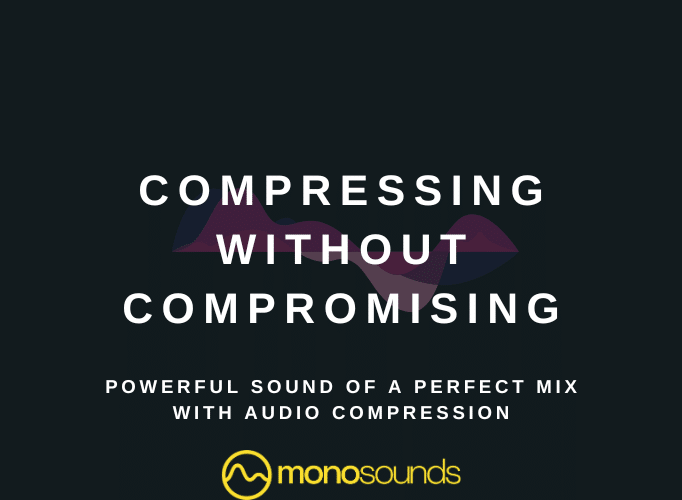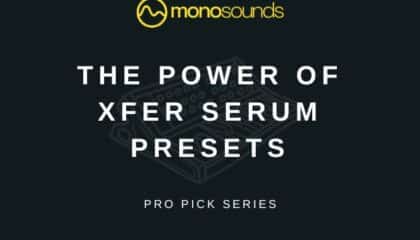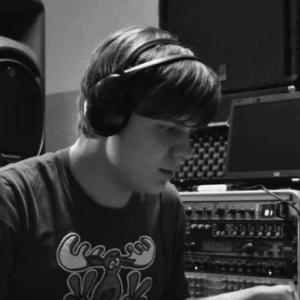
This is the my personal Top-5 of Xfer Serum Presets…

Music production and mixing are intricate operations that need a deep knowledge of sound engineering. Audio compression is a critical technology used by sound engineers and producers to obtain a professional sound. The process of audio compression balances the dynamics of a sound recording, making it more consistent and pleasurable to listen to.
In this post, we’ll go over the fundamentals of audio compression and how to utilize a compressor efficiently when mixing music. We’ll go over what audio compression is and how it works before delving into the various types of compressors and settings available to achieve the desired effects.
We’ll look at more sophisticated compression techniques, such as side-chain compression, parallel and multiband compression, and explain how to apply them to create dynamic and fascinating soundscapes in a separate section. We’ll show you how to use typical compression settings on different parts, such as vocals, percussion, and bass, to get the optimum balance in your mix.
Let us first define audio compression. Audio compression is a method that decreases the dynamic range of an audio stream. The dynamic range of a track is the difference between the loudest and quietest sections of the music. When you compress an audio signal, you reduce the level of the loudest sections of the recording while leaving the quieter parts alone. This evens out the overall level of the recording and makes it more pleasant to listen to.
Compression is accomplished via a compressor, which is a device or plug-in that applies certain settings to the audio signal. These options include threshold, ratio, attack, and attenuation times. They all work together to decide how the compressor will effect the dynamic range of the audio source. By altering these parameters, you may produce varied amounts of compression and generate distinct and intriguing sounds.
There are several types of compressors, each with its unique set of qualities and functions. Among the most common are:
VCA (Voltage-Controlled Amplifier) compressors. These are versatile instruments that are frequently used in mixing and mastering. They have a great level of accuracy and control, making them perfect for harmonic sound.
Optical Compressors. They compress the audio signal via optical electronics. They are well-known for their smooth and balanced sound, making them a popular option for vocals, guitar, and bass.
FET (Field Effect Transistor) compressors. They provide quick and strong compression, making them an excellent choice for percussion and other percussion instruments. They are also recognized for their characteristic “colorful” tone.
In sound compression, two important factors are the threshold and the ratio. The threshold is the loudness of the audio signal at which the compressor begins to lower its volume. When an audio signal crosses the threshold level, the ratio is the amount of gain reduction performed.
A threshold of -10 dB and a ratio of 2:1, for example, indicates that when the audio stream surpasses the -10 dB level, the compressor cuts the gain in half. If the audio signal hits -12 dB, the compressor will cut the gain in half, and so on.
Attack time is a parameter that determines how long it takes the compressor to fully compress the signal based on the Ratio value, immediately after the signal surpasses the predefined threshold value (Threshold).
Attack is the pace at which the volume decreases. Transients are preserved by a delayed compressor assault, whereas they are suppressed by a quick compressor attack. Milliseconds and microseconds are used to measure this characteristic.
Slow attack (from 10 to 100 ms) brings the music closer to the listener by preserving transients. Increases the importance of the sound, creating a “in your face” sensation. Suitable for instruments where chord clicks, melodic lines, and rhythms need to be emphasized.
Fast attack (from 0 to 10ms) – takes away the sound, “thinning” it, allowing you to make the instrument less prominent in the mix. At these settings, the compressor’s suppression of sound is most visible in the ear, as the device “chews up” the transients. For example, it is appropriate for “fill-in” components in the arrangement (such as pads, bass, and backup vocals), as well as signal thickening. Fast attack can also be used to decrease acoustic artifacts such as sharp clicks.
The release parameter specifies how long it takes for the signal to transition from its compressed form to its original uncompressed state. That is to say, Release is the inverse of Attack. It is timed in milliseconds and seconds. Normally, the release time will be substantially longer than the attack time. Depending on the kind and brand of compressor, release times range from 40-60 ms to 2-5 seconds.
This parameter influences the groove (rhythmic sensation) and “movement” of the rhythmic pattern in music mixing, as well as the length of the “tails” of the sounds. You may use Release to accentuate the lengths of the most prominent notes in the instrument, vocal, or percussion components. Release also has an impact on the sensation of so-called
Depending on the desired impact and individual audio qualities, the appropriate compression settings for various types of audio information might vary. Some popular compression settings for various types of audio content are listed below:
– Vocals. To create a natural sound, start with a threshold of -5 to -10 dB, a ratio of 2:1 to 4:1, an attack duration of 10 to 30 milliseconds, and a decay period of 100 to 300 milliseconds.
– Drums. To create a forceful sound, start with a threshold of -15 to -20 dB, a ratio of 4:1 to 6:1, an attack duration of 1 to 10 milliseconds, and an attenuation period of 50 to 100 milliseconds.
– Bass. Begin with a threshold of -10 to -15 dB, a ratio of 2:1 to 4:1, an attack time of 10 to 30 milliseconds, and an attenuation duration of 100 to 300 milliseconds for a tight and steady sound.
Sound compression is a strong instrument that may assist music producers and sound designers in producing professional-sounding music. Advanced approaches can take your mix to the next level.
Side-chain compression is a common method in various genres of music, including EDM, house, and hip-hop. It entails employing a distinct audio signal, such as a kick drum, to activate compression on another file, such as a bass line. This produces a pumping or bouncing effect in the mix, which adds energy and rhythm. The key to good side-chain compression is to fine-tune the threshold and ratio to produce the desired effect without making the compression too noticeable or distracting.
Parallel compression, commonly known as New York compression, is another method that may give depth and richness to a mix. It entails duplicating a track, aggressively compressing one duplicate, and then superimposing it on top of the uncompressed one. This produces a smoother and more balanced sound, with the compressed file lending stability to the original recording’s transients. You can get the right balance of dynamics and sustain by altering the mix of the two recordings.
Multiband compression is a more advanced approach that allows you to compress different frequency bands individually. This is important when working with complicated audio material that has varying frequencies across the spectrum. A voice track, for example, can include low frequencies and strong sibilance that must be adjusted independently. It is simple to have more control over the overall sound by separating the signal into many frequency bands and applying compression to each band independently. To avoid the appearance of distortion, carefully tune the crossover points and make minor tweaks to the compression settings.
Let’s look at some instances to see how these compression strategies work. In a dance music track, side-chain compression is applied to the bass line to create a pumping effect that is synced with the kick drum. You may modify the degree of compression as well as the quantity of original sound by altering the threshold and ratio. Parallel compression is used on drums in a rock mix to lend solidity to a track without compromising the punch and attack of the original sound. By combining the compressed and original tracks, you may produce a more powerful and rich sound. Multiband compression is used in vocal tracks to regulate the low-frequency hum and the high-frequency sibilant independently. By applying modest compression to certain frequency bands, the technician can
Understanding that various instruments have various dynamic ranges is crucial when blending music. For instance, voices frequently contain loud and quiet periods, exhibiting a large dynamic range. The dynamic range of drums is more consistent. A broad dynamic range may be found in bass instruments like the synth bass and bass guitar.
Understanding fundamental compressor settings is crucial for using compression successfully when mixing. The two factors deemed to be most crucial in determining how much signal compression occurs are threshold and compression ratio. Threshold establishes the point at which compression is performed, and ratio establishes the amount of gain reduction that is done to the signal over the threshold.
Being careful and controlled is crucial when adding compression to a mix. Excessive compression can quickly result in a loss of dynamics and a lifeless, uninteresting sound. Setting the threshold such that just the loudest portions of the signal are compressed is a good place to start. In order to accomplish the necessary gain reduction and preserve the instrument’s inherent dynamics, the ratio should be set appropriately.
Selecting the proper attack and attenuation periods is crucial when compressing voices. While a slower period will enable you to depict more realistic dynamics, a rapid attack time will aid in capturing the vocal’s first transients. The timing for the fade-in should be selected such that the compressor releases gradually.
The mix also includes drums, which are significant. In actual application, the snare drum’s dynamic range may be managed by the compressor to enhance the instrument’s percussion and detail without overpowering other components of the mix.
Additional compression is needed for bass instruments. When using a bass guitar or synth bass, a compressor enables you to manage the dynamic range while still preserving the instrument’s inherent dynamics. This keeps the bottom frequencies tight and concentrated.
Although the process of compressing audio may appear challenging and perplexing, we advise learning more about the techniques and uses of compression. Your ability to create music may be advanced to a whole new level with a little practice. You may always increase your compression abilities and use them to raise the caliber of your compositions, whether you’re a novice or a skilled professional.
With regard to using compression in music production, here are five pointers for beginners:

This is the my personal Top-5 of Xfer Serum Presets…

Welcome to the ultimate guide on how to use Xfer…

Hip hop music has been one of the most popular…

Greetings fellow sound engineers and music creators, and welcome to…
